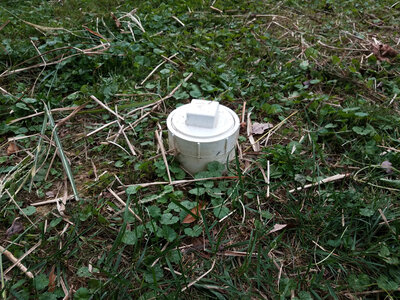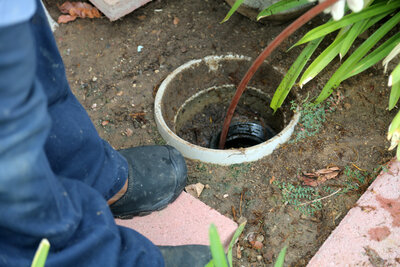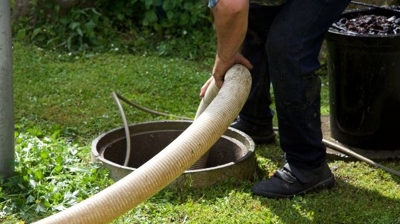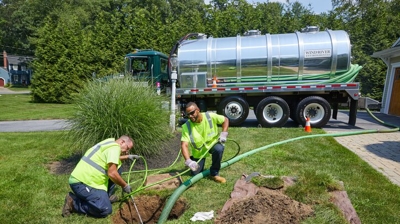Clogged septic system? Your toilets won't flush or, worse, you have sewage backup in your home?
Take a breath - many other homeowners like you have been there, too. You may also be able to resolve the issue yourself.
We provideseveral easy steps you can take to address a clogged septic system. While you may need to call a septic company, we at least want to help you identify the cause and determine how to address what could be a minor issue.
Step 1: Open Your Sewer Clean Out

![]()
First - locate and open your sewer cleanout, as shown above.
What You'll Need
You’ll need a sewer cleanout plug wrench, a large pipe wrench, or large channel locks.
Opening your sewer cleanout will allow everything that’s backed up in your drains to come out of the opening. Be prepared for sewage to spill out onto the ground.
Pro Tip
Place several old towels, a tarp, or absorbent material around the cleanout before opening it. Have a bucket or wheelbarrow ready nearby in case the spill is significant.
You’re dealing with sewage, waste, and toilet paper. So, wear gloves, old clothes, and old shoes.
Step 2: Open Your Septic Tank’s Inlet Access Riser

![]()
Next, open your septic tank inlet cover. Check out Step 1 of this blog for specific tips on opening your access riser.
Your septic tank should have at least two access risers - the inlet riser and the outlet riser. Open the inlet riser - it should be the one closest to your home.
Are you unsure where your septic tank and inlet riser are? Visit our 3 Tricks to Locating Your Septic blog for assistance.
Open the lid and see what’s going on inside.
Step 3: Assess What You See Inside Your Septic Tank
What do you see inside your septic tank? You’ll either see mostly water or a ton of solids.
If you see water, keep reading. If you see a crust of solid waste, jump down to 'Solid Waste? Call a Septic Company'.
Water? Likely a Septic & Drain Line Issue
If you see mostly water, well, that’s what you should see inside (1/2” layer of scum and solid waste is okay).
The issue is likely in the sewer/septic drain line that takes wastewater from your home into your septic tank.
Here are several possible issues:
- Clog. The septic drain line could be clogged with a combination of toilet paper and items that should not be flushed.
- Sewer Line Belly. You could have a sewer line belly. A sewer line belly is a portion of the sewer line that dips down. Bellies are a common cause of clogs.
- Tree Roots. You could have some tree roots clogging the septic drain line.
The main takeaway here is that you're dealing with a blockage between your house and the tank, which is a common problem.
If it's a clog, you might be able to clear it yourself. If it's not a clog, calling a local septic company is your best option.
How to Fix a Simple Septic Drain Clog

![]()
If it’s a simple clog in your drain line, you can likely unclog it yourself (be prepared to get a little dirty).
Follow these steps:
- Get a Drain Snake. Run to your local hardware store, let an employee know what’s going on, and ask them for advice on the best drain snake.
- Attempt Snaking via Septic Inlet. Stick the drain snake down the large white pipe leading into your septic tank. Pull back and forth as you work the snake up the drain line.
- Attempt Snaking via Sewer Cleanout. If this doesn’t work, return to the sewer cleanout and try snaking towards your house, then away from it.
You’ll know you got the clog when you see water flowing inside the cleanout and into your septic tank.
Did snaking your own septic and sewer drains work? If so, congratulations! Please give yourself a high-five from us, as you've just fixed your clogged septic tank.
If the DIY drain snake didn't clear your backup, that's okay, and good on you for trying!
Give a local septic company a call. Your septic company should be able to determine the cause and handle repairs.
Solid Waste? Call a Septic Company.
Now, if you see a thick crust or layer of solid waste, you may need to have your septic tank pumped.
Call a local septic pumping company, let them know you’re experiencing a backup in your home, and see if they can come out today or tomorrow.
During the service, the technician will likely start by pumping your tank. Next, they should inspect your septic system to ensure you don’t have issues with the baffles or drain field.
Pro Tip: Your septic company may not include an inspection in your service. So, don't be shy to ask them to inspect your system to ensure the clog isn't due to another issue.
Hopefully, all you need is a septic pumping service. However, if you require additional septic repairs, your septic company should guide you through the options and ensure you are taken care of.
When to Hand the Tools Over to Septic Contractors
We encourage you to try the steps above to save money. That said - there are times when DIY efforts can cause more damage or won't fix the core issue.
Your septic system is complex. Issues such as severe root intrusion, a damaged baffle, or a failing drain field require an expert.
If you've tried snaking and the backup persists, or if you suspect your tank is overloaded with solids, calling a professional is the safest and quickest path to a long-term solution.
Contact Wind River Environmental for Professional Help
Need a professional? You’re welcome to call us - we serve New England, the Mid-Atlantic, and the Southeast portions of the United States.
We’ve served in the septic and wastewater industry for over 70 years and have successfully handled countless clogged septic systems like yours.
Visit our Locations page to view our service area or contact us anytime. We offer 24/7 emergency service.



.2508141213110.png)
